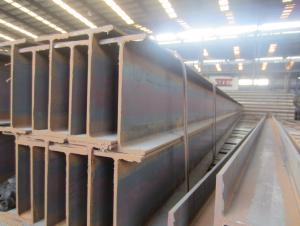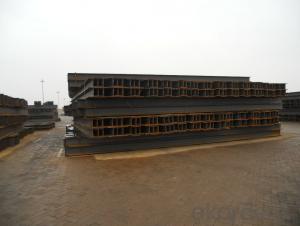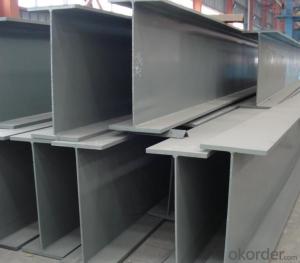JIS Standard Hot Rolled JIS Steel H-Beam
- Loading Port:
- China Main Port
- Payment Terms:
- TT or LC
- Min Order Qty:
- -
- Supply Capability:
- -
OKorder Service Pledge
OKorder Financial Service
You Might Also Like
Product Description:
OKorder is offering high quality Hot Rolled Steel I-Beams at great prices with worldwide shipping. Our supplier is a world-class manufacturer of steel, with our products utilized the world over. OKorder annually supplies products to European, North American and Asian markets. We provide quotations within 24 hours of receiving an inquiry and guarantee competitive prices.
Product Applications:
Commercial building structure ;Pre-engineered buildings; Machinery support structure; Prefabricated structure; Medium scale bridges; Ship-building structure. etc.
Product Advantages:
OKorder's Steel I-Beams are durable, strong, and resist corrosion.
Main Product Features:
· Premium quality
· Prompt delivery & seaworthy packing (30 days after receiving deposit)
· Corrosion resistance
· Can be recycled and reused
· Mill test certification
· Professional Service
· Competitive pricing
Product Specifications:
Manufacture: Hot rolled
Grade: Q195 – 235
Certificates: ISO, SGS, BV, CIQ
Length: 6m – 12m, as per customer request
Packaging: Export packing, nude packing, bundled
| H BEAM | ||||||
| size | h (MM) | b (MM) | t1 (MM) | t2 (MM) | Mass: Kg/m | LENGTH |
| 100x100 | 100 | 100 | 6.0 | 8 | 16.9 | 12M |
| 125x125 | 125 | 125 | 6.5 | 9 | 23.6 | 12M |
| 150x75 | 150 | 75 | 5.0 | 7 | 14.0 | 12M |
| 148x100 | 148 | 100 | 6.0 | 9 | 20.7 | 12M |
| 150x150 | 150 | 150 | 7.0 | 10 | 31.1 | 12M |
| 175x90 | 175 | 90 | 5.0 | 8 | 18.0 | 12M |
| 175x175 | 175 | 175 | 5.0 | 11 | 40.4 | 12M |
| 198x99 | 198 | 99 | 4.5 | 7 | 17.8 | 12M |
| 200x100 | 200 | 100 | 5.5 | 8 | 20.9 | 12M |
| 194x150 | 194 | 150 | 6.0 | 9 | 29.9 | 12M |
| 200x200 | 200 | 200 | 8.0 | 12 | 49.9 | 12M |
| 200x204 | 200 | 204 | 12.0 | 12 | 56.2 | 12M |
| 248x124 | 248 | 124 | 5.0 | 8 | 25.1 | 12M |
| 250x125 | 250 | 125 | 6.0 | 9 | 29.0 | 12M |
| 244x175 | 244 | 175 | 7.0 | 11 | 43.6 | 12M |
| 250x250 | 250 | 250 | 9.0 | 14 | 71.8 | 12M |
| 250x255 | 250 | 255 | 14.0 | 14 | 81.6 | 12M |
| 298x149 | 298 | 149 | 5.5 | 8 | 32.0 | 12M |
| 300x150 | 300 | 150 | 6.5 | 9 | 36.7 | 12M |
| 294x200 | 294 | 200 | 8.0 | 12 | 55.8 | 12M |
| 294x302 | 294 | 302 | 12.0 | 12 | 83.4 | 12M |
| 300x300 | 300 | 300 | 10.0 | 15 | 93.0 | 12M |
| 300x305 | 300 | 305 | 15.0 | 15 | 105.0 | 12M |
| 346x174 | 346 | 174 | 6.0 | 9 | 41.2 | 12M |
| 350x175 | 350 | 175 | 7.0 | 11 | 49.4 | 12M |
| 340x250 | 340 | 250 | 9.0 | 14 | 78.1 | 12M |
| 344x348 | 344 | 348 | 10.0 | 16 | 113.0 | 12M |
| 350x350 | 350 | 350 | 12.0 | 19 | 135.0 | 12M |
| 396x199 | 396 | 199 | 7.0 | 11 | 56.1 | 12M |
| 400x200 | 400 | 200 | 8.0 | 13 | 65.4 | 12M |
| 400x300 | 400 | 300 | 10.0 | 16 | 105 | 12M |
| 388x402 | 388 | 402 | 15.0 | 15 | 140 | 12M |
| 394x398 | 394 | 398 | 11.0 | 18 | 147 | 12M |
| 400x400 | 400 | 400 | 13.0 | 21 | 172 | 12M |
| 400x408 | 400 | 408 | 21.0 | 21 | 197 | 12M |
| 414x405 | 414 | 405 | 18 | 28 | 232 | 12M |
| 428x407 | 428 | 407 | 20 | 35 | 283 | 12M |
| 458x417 | 458 | 417 | 30 | 50 | 415 | 12M |
| 498x432 | 498 | 432 | 45 | 70 | 605 | 12M |
| 446x199 | 446 | 199 | 8 | 12 | 65.1 | 12M |
| 450x200 | 450 | 200 | 9 | 14 | 74.9 | 12M |
| 440x300 | 440 | 300 | 11 | 18 | 121 | 12M |
| 496x199 | 496 | 199 | 9 | 14 | 77.9 | 12M |
| 500x200 | 500 | 200 | 10 | 16 | 88.2 | 12M |
| 506x201 | 506 | 201 | 11 | 19 | 102 | 12M |
| 482x300 | 482 | 300 | 11 | 15 | 111 | 12M |
| 488x300 | 488 | 300 | 11 | 18 | 125 | 12M |
| 596x199 | 596 | 199 | 10 | 15 | 92.5 | 12M |
| 600x200 | 600 | 200 | 11 | 17 | 103 | 12M |
| 606x201 | 606 | 201 | 12 | 20 | 118 | 12M |
| 582x300 | 582 | 300 | 12 | 17 | 133 | 12M |
| 588x300 | 588 | 300 | 12 | 20 | 147 | 12M |
| 594x302 | 594 | 302 | 14 | 23 | 170 | 12M |
| 692x300 | 692 | 300 | 13 | 20 | 163 | 12M |
| 700x300 | 700 | 300 | 13 | 24 | 182 | 12M |
| 792x300 | 792 | 300 | 14 | 22 | 188 | 12M |
| 800x300 | 800 | 300 | 14 | 26 | 207 | 12M |
| 890x299 | 890 | 299 | 15 | 23 | 210 | 12M |
| 900x300 | 900 | 300 | 16 | 28 | 240 | 12M |
| 912x302 | 912 | 302 | 18 | 34 | 283 | 12M |
FAQ:
Q1: Why buy Materials & Equipment from OKorder.com?
A1: All products offered byOKorder.com are carefully selected from China's most reliable manufacturing enterprises. Through its ISO certifications, OKorder.com adheres to the highest standards and a commitment to supply chain safety and customer satisfaction.
Q2: Can stainless steel rust?
A2: Stainless does not "rust" as you think of regular steel rusting with a red oxide on the surface that flakes off. If you see red rust it is probably due to some iron particles that have contaminated the surface of the stainless steel and it is these iron particles that are rusting. Look at the source of the rusting and see if you can remove it from the surface.
Q3: How soon can we receive the product after purchase?
A3: Within three days of placing an order, we will begin production. The specific shipping date is dependent upon international and government factors, but is typically 7 to 10 workdays.
Images:
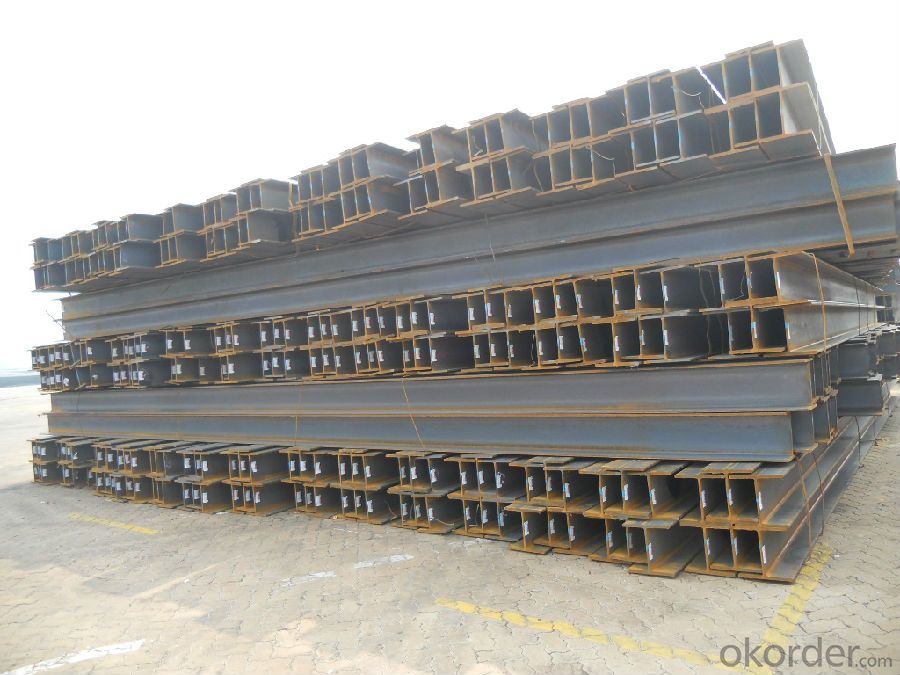
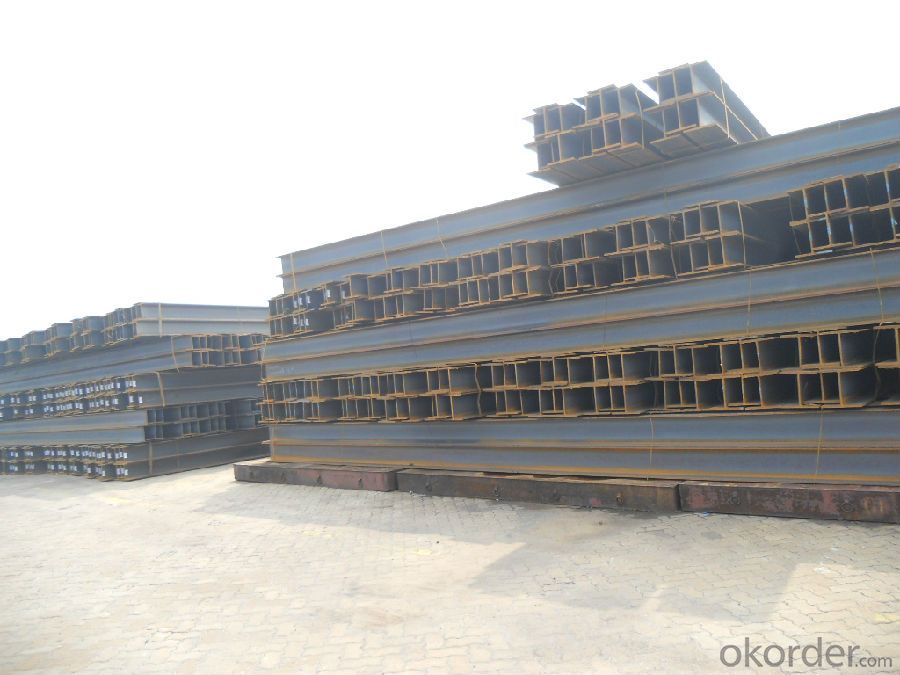
- Q:What are the different methods of installing steel H-beams?
- Installing steel H-beams can be done using various methods, depending on the project requirements and available resources. Below are some commonly used techniques: 1. The first method involves the use of heavy machinery like cranes or forklifts to lift and position the steel H-beams. This approach is typically employed for larger structures or when installing beams at significant heights. 2. Welding is another common technique used to connect steel H-beams either to each other or to other structural elements. It requires melting and fusing the metal to create a strong joint. Welding can be carried out on-site or in a fabrication shop, depending on the project's needs. 3. Bolting is a method where bolts and nuts are used to secure the steel H-beams together or to other structural components. Bolting is often favored in situations where future disassembly or modifications may be necessary. 4. Concrete embedment is employed when additional stability and support are required. Steel H-beams are embedded in concrete by creating holes in the concrete structure and placing the beams into them. The beams are then held in place as the concrete sets. 5. Steel plates and brackets can also be utilized to connect steel H-beams to other structural elements. These plates are typically attached to the beams through bolting or welding and then affixed to the desired location. It is crucial to consider factors such as project requirements, structural design, and available resources when choosing the appropriate method for installing steel H-beams. Seeking advice from a structural engineer or construction professional is highly recommended for determining the most suitable installation approach for a specific project.
- Q:How do Steel H-Beams contribute to the overall occupant comfort of a building?
- There are several ways in which Steel H-Beams enhance the comfort of building occupants. Firstly, they ensure the building's structural stability and support, guaranteeing the safety and security of those inside. H-Beams are designed to bear heavy loads and resist bending, preventing any structural issues or collapse. This, in turn, instills a sense of peace and security in occupants, knowing they are in a structurally sound building. Secondly, H-Beams possess a high fire resistance rating. Steel, being non-combustible, is often used in fire-resistant construction systems. Hence, H-Beams can prevent the spread of flames in case of a fire and provide a safe escape route for occupants. This fire resistance greatly enhances occupant comfort as it reduces the risk of injury or loss of life. Furthermore, H-Beams are renowned for their durability and longevity. Unlike other building materials, steel is resistant to rotting, warping, and decay. Consequently, H-Beams maintain their structural integrity over time, minimizing the need for frequent repairs and maintenance. This stability and reliability contribute to occupant comfort by minimizing disruptions caused by building maintenance. Additionally, the use of Steel H-Beams allows for open and flexible floor plans. With their high strength-to-weight ratio, H-Beams can support large spans without the need for excessive columns or walls. This creates spacious interiors, offering greater flexibility in interior design and layout. Occupants can enjoy a sense of freedom and adaptability in utilizing their space, enhancing overall comfort and satisfaction. Lastly, Steel H-Beams provide excellent sound insulation properties. Due to their mass and density, they effectively block external noise, such as traffic or construction sounds, and reduce sound transmission within the building. This results in a quieter and more peaceful environment, promoting a sense of tranquility and well-being for occupants. In conclusion, Steel H-Beams significantly contribute to the overall comfort of building occupants by ensuring structural stability, fire resistance, durability, open floor plans, and sound insulation. Their ability to enhance safety, security, and create pleasant living or working environments ensures that occupants can experience comfort and enjoyment in the building.
- Q:What are the different types of steel H-beam connections for high-temperature environments?
- There are several types of steel H-beam connections suitable for high-temperature environments. Some common options include bolted connections, welded connections, and hybrid connections that combine both welding and bolting techniques. Additionally, specialized heat-resistant materials, such as high-temperature alloys or coatings, can be used to enhance the performance and durability of these connections in extreme heat conditions. The choice of connection type depends on factors such as the specific application, load requirements, and the level of temperature resistance needed.
- Q:What are the guidelines for handling and installing steel H-beams?
- The guidelines for handling and installing steel H-beams include ensuring proper lifting techniques are used, using appropriate lifting equipment with adequate capacity, properly securing the beams during transport, maintaining a level and stable surface during installation, aligning and supporting the beams correctly, following the manufacturer's instructions and specifications, and conducting regular inspections for any signs of damage or defects. Additionally, it is important to adhere to relevant safety regulations and guidelines, and consult with a qualified professional or engineer if needed.
- Q:What are the common challenges faced during the installation of steel H-beams?
- During the installation of steel H-beams, there are several common challenges that may be encountered. These challenges include: 1. Weight and size: Steel H-beams are usually large and heavy, making them difficult to handle and maneuver during installation. The weight and size of these beams can pose challenges in terms of transportation and positioning on the construction site. 2. Alignment: Achieving proper alignment of H-beams is crucial for structural integrity. It can be challenging to ensure that the beams are perfectly aligned vertically and horizontally, especially when dealing with multiple beams or long spans. 3. Connection methods: H-beams need to be securely connected to other structural elements, such as columns or foundations. Selecting the appropriate connection method and ensuring its proper execution can be a challenge, as it requires specialized knowledge and expertise. 4. Crane and equipment limitations: The installation of steel H-beams often requires the use of cranes and other heavy equipment. However, these equipment have their limitations in terms of lifting capacity, reach, and access to the construction site. Overcoming these limitations can be a challenge, especially in tight or congested areas. 5. Safety considerations: The installation of steel H-beams involves working at height and handling heavy materials. This raises safety concerns for the workers involved. Ensuring proper safety measures, such as fall protection, proper lifting techniques, and adequate training, is critical to mitigate these risks. 6. Site conditions: The condition of the construction site can also present challenges during the installation of steel H-beams. Uneven or unstable ground, restricted access, or adverse weather conditions can all impact the installation process and require additional planning and precautions. To overcome these challenges, it is essential to have a well-coordinated plan, skilled personnel, and proper equipment. Engaging experienced professionals and ensuring effective communication among all parties involved can help address these challenges and ensure a successful installation of steel H-beams.
- Q:Can steel H-beams be used in temporary structures?
- Indeed, temporary structures can incorporate steel H-beams. In construction, H-beams are renowned for their robustness, endurance, and adaptability. They are frequently employed in the assembly of temporary structures like scaffolding, temporary bridges, or supportive frameworks for temporary stages or platforms. The exceptional load-bearing capacity of steel H-beams ensures stability and structural soundness in temporary structures. Furthermore, their modular configuration facilitates effortless assembly and disassembly, rendering them exceptionally well-suited for temporary purposes.
- Q:How do steel H-beams perform in high-wind areas?
- Steel H-beams are designed to be strong and rigid, making them highly effective in high-wind areas. Their structural integrity allows them to withstand the strong forces exerted by high winds, ensuring stability and preventing structural failure. Moreover, H-beams are commonly used in construction projects specifically for their ability to resist bending and twisting, which further enhances their performance in high-wind areas.
- Q:In the steel structure, the semifinished product H steel column, whether also sets the manufacture quota?
- Bored pile: drilled into the depth of rock (the municipal and highway quota projects contain a great gap in content)
- Q:What are the typical applications of steel H-beams?
- Steel H-beams, also known as I-beams, are widely used in various construction and structural applications due to their unique shape and versatile properties. Some of the typical applications of steel H-beams include: 1. Building Construction: H-beams are commonly used in the construction of buildings and structures such as bridges, high-rise buildings, warehouses, and industrial facilities. They provide excellent structural support and stability, making them ideal for load-bearing applications. 2. Infrastructure Projects: H-beams are extensively used in infrastructure projects such as highways, railways, and airports. They are employed in the construction of supports for elevated roadways and rail tracks, as well as in the fabrication of large-scale structures like overhead gantries and pedestrian bridges. 3. Mezzanine Floors: Steel H-beams are often used in the construction of mezzanine floors, which are intermediate floors installed between the main floors of a building. H-beams allow for efficient space utilization by providing strong and sturdy support for the additional floor without the need for excessive columns or support structures. 4. Industrial Machinery and Equipment: H-beams find applications in the manufacturing and industrial sectors as well. They are used in the construction of heavy machinery, equipment frames, and supports for conveyor systems. The high strength and load-bearing capacity of H-beams make them suitable for handling heavy loads in industrial settings. 5. Shipbuilding: H-beams are commonly utilized in the shipbuilding industry for the construction of ship hulls, decks, and bulkheads. The robust nature of steel H-beams ensures structural integrity and stability, making them ideal for withstanding the harsh marine environment and heavy loads encountered by ships. 6. Automotive Industry: Steel H-beams also find applications in the automotive industry. They are used in the fabrication of vehicle frames, chassis, and suspension systems, providing strength and rigidity to ensure the safety and performance of automobiles. 7. Material Handling Equipment: H-beams are employed in the construction of material handling equipment such as cranes, forklifts, and hoists. Their structural strength enables them to handle and transport heavy loads efficiently and securely. Overall, the versatility, strength, and durability of steel H-beams make them suitable for a wide range of applications in various industries. They are a preferred choice for construction and structural projects where load-bearing capacity, stability, and reliability are crucial factors.
- Q:Are Steel H-Beams resistant to mold or mildew?
- Yes, steel H-beams are resistant to mold or mildew growth due to their non-porous and non-organic nature.
1. Manufacturer Overview |
|
|---|---|
| Location | |
| Year Established | |
| Annual Output Value | |
| Main Markets | |
| Company Certifications | |
2. Manufacturer Certificates |
|
|---|---|
| a) Certification Name | |
| Range | |
| Reference | |
| Validity Period | |
3. Manufacturer Capability |
|
|---|---|
| a)Trade Capacity | |
| Nearest Port | |
| Export Percentage | |
| No.of Employees in Trade Department | |
| Language Spoken: | |
| b)Factory Information | |
| Factory Size: | |
| No. of Production Lines | |
| Contract Manufacturing | |
| Product Price Range | |
Send your message to us
JIS Standard Hot Rolled JIS Steel H-Beam
- Loading Port:
- China Main Port
- Payment Terms:
- TT or LC
- Min Order Qty:
- -
- Supply Capability:
- -
OKorder Service Pledge
OKorder Financial Service
Similar products
New products
Hot products
Related keywords





















